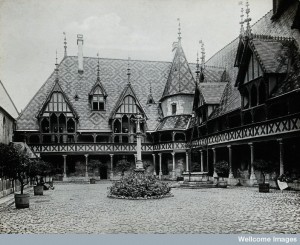By Lisa Smith (W&M Regular Contributor)
 After the Battle of Rocoux (11 October, 1746), several Dutch prisoners of war were held in Beaune (Burgundy). Townsmen were recruited as guards, with local lawyers and physicians – men of responsibility – as captains. Physician Vivant-Augustin Ganiare (1698-1781) expressed concerns about the prisoners being a potential source of contagion in November. They had dysentery and seemed to be the source of a local worm outbreak.
After the Battle of Rocoux (11 October, 1746), several Dutch prisoners of war were held in Beaune (Burgundy). Townsmen were recruited as guards, with local lawyers and physicians – men of responsibility – as captains. Physician Vivant-Augustin Ganiare (1698-1781) expressed concerns about the prisoners being a potential source of contagion in November. They had dysentery and seemed to be the source of a local worm outbreak.
Over Christmas, several young captains provided their men with wine and tobacco to help morale, which led first to “bacchanals” and then to the worst-ever hangover: a flu-like epidemic for the whole town. Men, especially those who had been on recent guard duty, were the main victims. Women and children in turn caught it from male family members.
An unnamed ‘Monsieur’ aged 37 was typical. He spent two nights on watch with his friends, where they drank and danced with the prisoners. Off duty, he ran about the streets in “excessive joy”. The alcohol’s effects were worsened by sudden temperature changes between the heat of revelry and the cold outside.
Fraternization was bad enough, but the underlying problem was failed leadership. Ganiare was unsurprised that nearly all of Monsieur Navetier’s men had died since Navetier had been particularly generous. The captains should have known better than to give their men booze. The entire town now suffered from their foolishness!
Ganiare maintained detailed notes of interesting cases and monthly summaries of general health trends, crops and weather. As a man of science, Ganiare wanted to identify patterns in epidemics and weather; as a religious man, he hoped to see the hand of God in nature. By uncovering nature’s secrets, he hoped to control disease outbreaks.
This time Ganiare had no need to search further for nature’s secrets. His conclusion? The epidemic, caused by fraternization and carousing, had been entirely preventable.
A cautionary tale for the festive season…
Lisa Smith is an Associate Professor of History at the University of Saskatchewan. She writes on gender, family, and health care in England and France (ca. 1600-1800).
Image: Hospital (Hôtel-Dieu), Beaune: courtyard. Credit: Wellcome Library, London.
